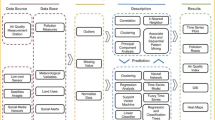Abstract
Air pollution has become a critical problem in rapidly developing countries. Prior domain knowledge combined with data mining offers new ideas for air quality prediction. In this paper, we propose an interdisciplinary approach for air quality forecast based on data mining and air mass trajectory analysis. The prediction model is composed of a temporal predictor based on local factors, a spatial predictor based on geographical factors, an air mass predictor tracking air pollutants transport corridors and an aggregator for final prediction. Experimental results based on real world data show that the cross-domain data mining method can significantly improve the prediction accuracy compared with other baselines, especially in the period of severe pollution.
Access this chapter
Tax calculation will be finalised at checkout
Purchases are for personal use only
Similar content being viewed by others
References
Zhang, B., et al.: Learning-based energy-efficient data collection by unmannedvehicles in smart cities. IEEE Trans. Industr. Inf. 14(4), 1666–1676 (2018)
Feng, C., et al.: Estimate air quality based on mobile crowd sensing and big data. IEEE WoWMoM (2017)
Stadlober, E., et al.: Quality and performance of a PM10 daily forecasting model. Atmos. Environ. 42(6), 1098–1109 (2008)
Gao, H., et al.: A survey of incentive mechanisms for participatory sensing. IEEE Commun. Surv. Tutorials (2017)
Djalalova, I., et al.: PM2.5 analog forecast and Kalman filter post-processing for the community multiscale air quality (CMAQ) model. Atmos. Environ. 108, 76–87 (2015)
Chen, J., et al.: Smog disaster forecasting using social web data and physical sensor data. In: IEEE Big Data (2015)
Tang, J., et al.: Extreme learning machine for multilayer perceptron. IEEE Trans. Neural Networks Learn. Syst. 27(4), 809–821 (2016)
Buehner, M.J., et al.: Four-dimensional ensemble-variational data assimilation for global deterministic weather prediction. Nonlinear Process. Geophys. 20(5), 669–682 (2013)
Perez, P., et al.: An integrated neural network model for PM10 forecasting. Atmos. Environ. 40(16), 2845–2851 (2006)
Kota, S.H., et al.: Evaluation of on-road vehicle CO and NO\(_{x}\) National Emission Inventories using an urban-scale source-oriented air quality model. Atmos. Environ. 82, 99–108 (2014)
Chen, T., et al.: Xgboost: a scalable tree boosting system. In: ACM SIGKDD International Conference (2016)
Feng, X., et al.: Formation and dominant factors of haze pollution over Beijing and its peripheral areas in winter. Atmos. Pollut. Res. 5(3), 528–538 (2014)
Morelli, X., et al.: Air pollution, health and social deprivation: a fine-scalerisk assessment. Environ. Res. 147, 59–70 (2016)
Zheng, Y., et al.: U-air: When urban air quality inference meets big data. In: ACM SIGKDD International Conference (2013)
Zheng, Y., et al.: Forecasting fine-grained air quality based on big data. In: ACM SIGKDD International Conference (2015)
Qi, Z., et al.: Deep air learning: Interpolation, prediction, and feature analysis of air quality. IEEE Trans. Knowl. Data Eng. 30(12), 2285–2297 (2018)
Acknowledgement
This work was supported by National Natural Science Foundation of China (Grant No.61602051).
Author information
Authors and Affiliations
Corresponding author
Editor information
Editors and Affiliations
Rights and permissions
Copyright information
© 2019 Springer Nature Switzerland AG
About this paper
Cite this paper
Feng, C., Wang, W., Tian, Y., Gong, X., Que, X. (2019). Data and Knowledge: An Interdisciplinary Approach for Air Quality Forecast. In: Douligeris, C., Karagiannis, D., Apostolou, D. (eds) Knowledge Science, Engineering and Management. KSEM 2019. Lecture Notes in Computer Science(), vol 11775. Springer, Cham. https://doi.org/10.1007/978-3-030-29551-6_70
Download citation
DOI: https://doi.org/10.1007/978-3-030-29551-6_70
Published:
Publisher Name: Springer, Cham
Print ISBN: 978-3-030-29550-9
Online ISBN: 978-3-030-29551-6
eBook Packages: Computer ScienceComputer Science (R0)





